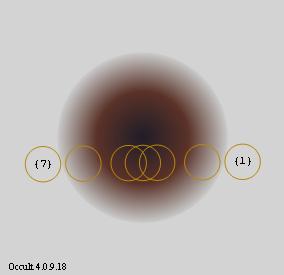SkyCaramba weekly astronomy blog for the week ending December 10, 2011
Most of the eastern hemisphere gets to see a lunar eclipse December 10th. The moon will spend 51 minutes in the darkest part of the earth’s shadow.
Most months, the moon passes too far north or south of the earth’s shadow to be eclipsed. When there is an eclipse, it could be penumbral, partial, or total. There could be almost no eclipse at all or the moon can pass completely within the shadow.

A penumbral eclipse happens when the moon goes into Earth’s outer shadow. If you could see the sun from the moon at such a time, you’d see the earth partially eclipsing the sun. Some sunlight reaches the moon’s surface during a penumbral eclipse and it takes careful observing to see change in brightness. Sometimes there may be a change in color as the sunlight passes through Earth’s atmosphere and shines on the moon in sunrise or sunset colors.
For a partial lunar eclipse, part of the moon is in the deepest shadow called the umbra. The rest of the moon stays in the penumbra. From the parts in the penumbra, the sun would continue to appear partially eclipsed by the earth. From those in the umbra, the earth completely blocks the sun.
For a total eclipse, the entire moon passes through the earth’s umbra. That’s what will happen on December 10th. As you might have guessed, to get to the umbra, the moon has to pass into the penumbra first. So you can expect to see the penumbral phase, the partial phase, then the total phase. The second half of the eclipse is in reverse. The eclipse becomes partial, then penumbral, then the moon returns to full light outside any of the shadow.
Thousands of years ago, eclipses were feared in many cultures. Before our modern understanding of why eclipses happened, a culture’s accepted explanation may have been that some supernatural power hid the moon to show displeasure. Elders may have stirred large numbers of people to make sacrifices and prayers to appeal to a god to return the moon to them. When the eclipse ended, they thought they had done right.
Watch how the earth’s shadow crosses the moon during a lunar eclipse and you’ll see that the shadow is curved. They couldn’t prove it, but observers in ancient Greece actually suspected they were watching the moon pass through Earth’s shadow. If you think about how lunar eclipses only happen when the moon is full and you note that the sun is setting while the full moon rises, it’s easy to visualize the earth being perfectly situated between the two. And since shadows tend to approximate the shape of whatever they belong to, the earth would have to be round.

You can enjoy a lunar eclipse with the naked eye. Viewing through binoculars or a telescope can make it more fun though. If you’re in a part of the world excluded from this month’s event, you may find that several astronomers around the world are streaming views from their own back yards on the Internet. However you view it, make the most of the experience. It’ll be the last total lunar eclipse until April 15, 2014.
Useful web sites:
http://eclipse.gsfc.nasa.gov/OH/OH2011.html#LE2011Dec10T NASA’s page by Fred Espenak
http://www.astronomylive.com/event/total-lunar-eclipse-10-december-2011 Astronomy Live should have a few webcasts of the event.
Images on this page were made with the WinOccult program, issued by the International Occultation Timing Association.